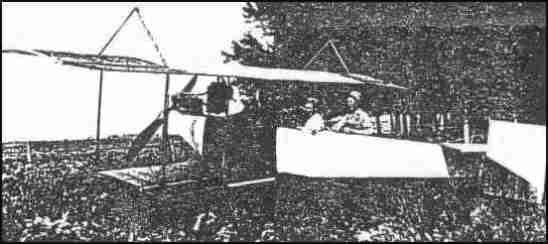
 |
|
From a News Clipping from the Stuart Herald Kindly provided by Harold Duede |
|
Carl Duede's career in aviation started in 1907. Working with him were two friends, William Couch and Olney Wilde. Olney's father was dead-set against his boy being a flyer, so Olney had to participate largely under cover, and his father finally terminated his operations as a safety measure! The two, Carl Duede and Will Couch, continued to work side by side perfecting gliders and motored planes. Being constantly involved in experiments connected with flying, Carl decided to build a balloon for himself, so he got a big piece of muslin and had his mother sew it into a cigar-shaped bag, in hope of putting on exhibitions in order to get enough funds to purchase a motor. Then he rigged up an old bicycle to hang under the balloon for the power plant, and whittled out a home-made propeller. To ascertain how much thrust was in the one-man power plant, he tied the airship to a tree limb and pumped the bicycle vigorously. That test was ssatisfactory; but the next obstacle was a real problem. Carl said, "To fill our fore-runner-of-a-blimp with hot air, we dug a long trench in the ground. We placed the bag over the hole at one end, and built a fire at the other." He and his friends fanned with all their might to force the hot air into the bag, but the mesh in the cloth was so loose that the hot air went right on through. The result of this discovery led Carl and his helpers to dip the bag in linseed oil to make it airtight; then they hung it on the clothesline to dry. But, having to make a trip to the store, they brought the oily bag into the kitchen to prevent any tampering with it. While they were gone, the bag caught fire from spontaneous combustion, and (but for the quick work of Carl's mother), the house would have gone up in flames! Strange to say, the precious airship was still intact, and another attempt was made in a few days to fill it with hot air. But try as they would, the bag was not only airtight but moisture-tight. The fire being built on dampy ground, caused a vapor to rise; and when the bag was about half inflated, the water which had gone in with the hot air was so heavy that the bag began to sag. This caused the airship idea to be discarded in favor of a heavier-than-air machine. Carl and his friend Will Couch then decided to build gliders, the first of which was contructed in 1907 in the family barn behind the Duede house. The framework of the glider was made of oak with wire struts and Carl's mother helped to cover the wings and fuselage with muslin. .......................More to Follow Courtesy of Harold Duede, 3-5-01 |
|
You will find a brief reference to William You can visit that reference by clicking on: William Couch and using the "Find" function on "Couch" |
|
When the United States entered World War I in 1917, in a state of unpreparedness, no need of the
army was more pressing than that felt for flying instructors to asist in carrying forward the enormous aviation program which had been
planned. There were but a few officers in the army who had any experience in flying or could "take up" a ship. The War Department
issued an appeal to all the country's civilian flyers for volunteers to render a special and peculiar service as flying instructors. The
response was immediate. Practically every civilian pilot in the country offered his services, and Will Couch of Stuart was one of them.
The occupation of these men was most hazardous. They not only taught the green flyers, but they
also tested new machines and repaired them. Testing is among the most dangerous of a flyer's activities. many civilian flight instructors
were killed those early days, teaching the young military flyers to handle a plane. Of the 140 civilian who volunteered their services,
only 40 survived. Will Couch of Stuart was among those instructors. and he gave up his life on a flying field in Louisiana, where he
and Carl Duede were both serving their country in this hour of urgent need. Courtesy of Harold Duede, 3-5-01 |
|
If you have any more information on this pioneer aviator, please contact me. E-mail to Ralph Cooper Back 

|